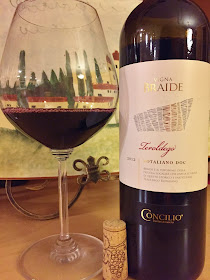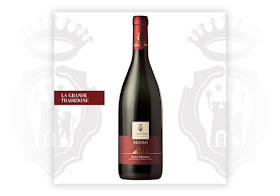There's nothing like conversing with friends over a glass of wine and
meeting other lovers of wine, but how about meeting the founder of
the #winelover community that gathers all those passionate about wine
from around the world? This interview is with Luiz Alberto, a local
winelover to the Boston area, whom is a wine educator and
communicator that has created an amazing community of winelovers.
I believe
you're Italian by blood. What part of Italy does your family
originate from?
My father’s side of the family
comes from the Veneto and my mother’s side from Lombardy.What originally got you into wine?
Well, this question has 2 answers: 1) I got into liking to drink wine as a child. The entire family would get together on Sundays for lunch and wine was a big part of it. The adults would drink wine and we (the kids) would drink what we thought was wine, but that actually was a mixture of water (a lot of it!), sugar, and a tiny little bit of wine.
2) I got into liking to learn about wine when I moved to
the US back in 1996. After going to a couple of wine stores and
finding out how many options were available, I decided that I needed
to learn about it. And then my life changed! :)
Being founder of the #winelover community, what influenced you to start this group? How large is it now?
Before I answer your question, let me tell you what “#winelover" is. #winelover is a strong, connected, and dynamic community that expresses itself through the use of social media. The community exists to promote cooperation and enjoyment among people who love wine. Periodic hangouts throughout the world are organized for the community to have the opportunity to get together in ‘real life’. It’s been a little over 4 years since I started it and this statement makes it very clear to me why we needed such a community. We needed to get together to share wine! Anyway, at first I thought it was going to be only me and my 7 friends… but it become a huge thing and today we have over 21,000 members on our group and it’s growing everyday.
I know you're currently enrolled in the prestigious Masters of Wine program. Where do you currently stand with the program?
I’ve been in the Masters of Wine program since 2009. I sat the exam for the first time last year in June and I didn’t pass. The examinations are taking place again now but I’m not trying this year. Basically my status is “on hold” at this point, but I have to make a decision in September if I will go back to the program or not. Too many things on my plate at the moment and studying for the MW program may put my life out of balance. Let’s see…
Tell me about the Italian Wine Ambassador program and how that has benefited your career in wine?
Being founder of the #winelover community, what influenced you to start this group? How large is it now?
Before I answer your question, let me tell you what “#winelover" is. #winelover is a strong, connected, and dynamic community that expresses itself through the use of social media. The community exists to promote cooperation and enjoyment among people who love wine. Periodic hangouts throughout the world are organized for the community to have the opportunity to get together in ‘real life’. It’s been a little over 4 years since I started it and this statement makes it very clear to me why we needed such a community. We needed to get together to share wine! Anyway, at first I thought it was going to be only me and my 7 friends… but it become a huge thing and today we have over 21,000 members on our group and it’s growing everyday.
I know you're currently enrolled in the prestigious Masters of Wine program. Where do you currently stand with the program?
I’ve been in the Masters of Wine program since 2009. I sat the exam for the first time last year in June and I didn’t pass. The examinations are taking place again now but I’m not trying this year. Basically my status is “on hold” at this point, but I have to make a decision in September if I will go back to the program or not. Too many things on my plate at the moment and studying for the MW program may put my life out of balance. Let’s see…
Tell me about the Italian Wine Ambassador program and how that has benefited your career in wine?
"330 DOCs, 73 DOCGs and over 541 native grape varieties” (Source: D’Agata I. Native Wine Grapes of Italy, University of California Press, Berkeley, 2014). Yes, you read it right… and this (D’Agata’s book) was the syllabus for our course to become Italian Wine Ambassadors. I studied really hard and I was "top 5" of a class of 50 very prepared students. Quite an honor, but hard to measure how it has impacted my wine career. I know it has benefited me (I know I learned a lot!), but people don’t really tell me why I’m invited to be a speaker or to attend an important seminar.
When it comes to the world of wines where do Italian wines rank for you?
This question is very hard to answer as I have many passions in the world of wine. However, if you count the number of visits to a country for wine reasons as the criteria to determine the ranking, then certainly Italy comes as number 1. I have been to Italy dozens of times and I visited all their wine regions with the exception of one: Sardinia. But this, hopefully, will be fixed soon!
It may be hard to do, but what are some of your favorite Italian grapes?
A question that begs for an impossible answer! It would be easy to go with the usual suspects and say that I love Sangiovese and Nebbiolo (which I do!) but I would be unfair to so many others that I don’t think I should even try… Do you remember how I started this interview? Yes… 541 native grape varieties!!
What regions/areas do you feel produce some of the best values for Italian wines?
Value? Here’s one of its definitions: "The extent to which a good or service is perceived by its customer to meet his or her needs or wants, measured by customer's willingness to pay for it. It commonly depends more on the customer's perception of the worth of the product than on its intrinsic value.” What does it mean? It means that a bottle of Brunello di Montalcino at $50.00 can be a great value to a consumer that praises that wine, while a bottle of Donnie (a DOC wine from Calabria made from Gaglioppo with some blending of Greco nero and Mantonico nero) that costs $5.00 seems not to be such a good deal because you never heard of it, right? In other words, all Italian wine regions have amazing values. You just need to trust your own palate and be adventurous.
What role and influence do you feel social media and wine bloggers have on the wine industry?
I believe that wine and social media are a great pairing. As much as the traditional wine media (e.g. Wine Spectator) is still influential to consumers, more and more people base their buying decisions on social media and wine bloggers today. The result of this “change of the guard” is that the role of some of the most influential bloggers is forcing brands to become very creative to build interaction with their consumers and, at the end of the day, generate sales. But it’s definitely not only about famous names with big audiences. Social media has enabled people to make their wine choices based on what their friends liked (or didn’t like) and that they shared via Tweeter, Facebook, or Instagram. And this influence will only grow in years to come. The future is bright.
*Pictures were provided by Luiz Alberto. This article was originally published for my column, Uncorked Italy, in the former Bostoniano magazine.







